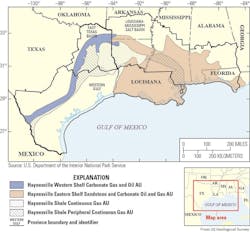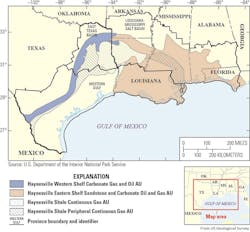The Upper Jurassic Bossier and Haynesville formations along the US Gulf Coast together represent a mean undiscovered, technically recoverable natural gas resource of 304.4 tcf, according to the US Geological Survey.
The new estimate is “the largest continuous natural gas assessment USGS has yet conducted,” the agency said.
The formations onshore and in state waters also represent mean undiscovered, technically recoverable resources of 4 billion bbl of oil and 1.9 billion bbl of NGL, USGS said.
The assessment covered potential in conventional and continuous reservoirs.
USGS estimated mean Bossier resources at 108.6 tcf of gas, 2.9 billion bbl of oil, and 1 billion bbl of NGL.
It estimated mean Haynesville resources at 195.8 tcf of gas, 1.1 billion bbl of oil, and 900 million bbl of NGL.
In a 2010 assessment of Jurassic and Cretaceous potential on the Gulf Coast, USGS estimated gas resources at 9 tcf in the Bossier and 61.4 tcf in the Haynesville.
“Since the 2010 assessment, we’ve gotten updated geologic maps, expanded production history, and have a greater understanding of how these reservoirs evolved,” said USGS scientist Stan Paxton, author of the assessment. “All of that leads to a better geological model and therefore a more robust assessment.”

